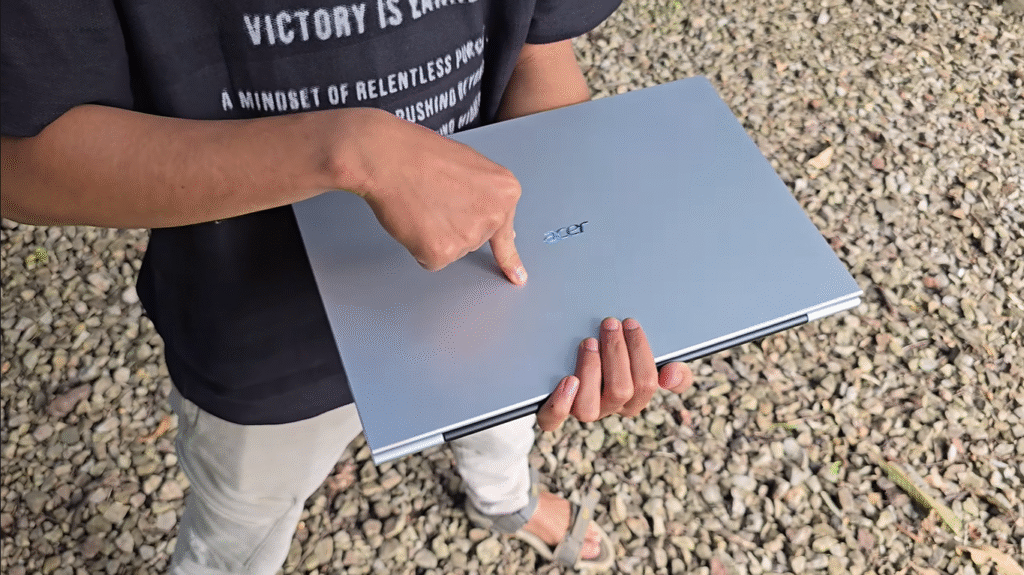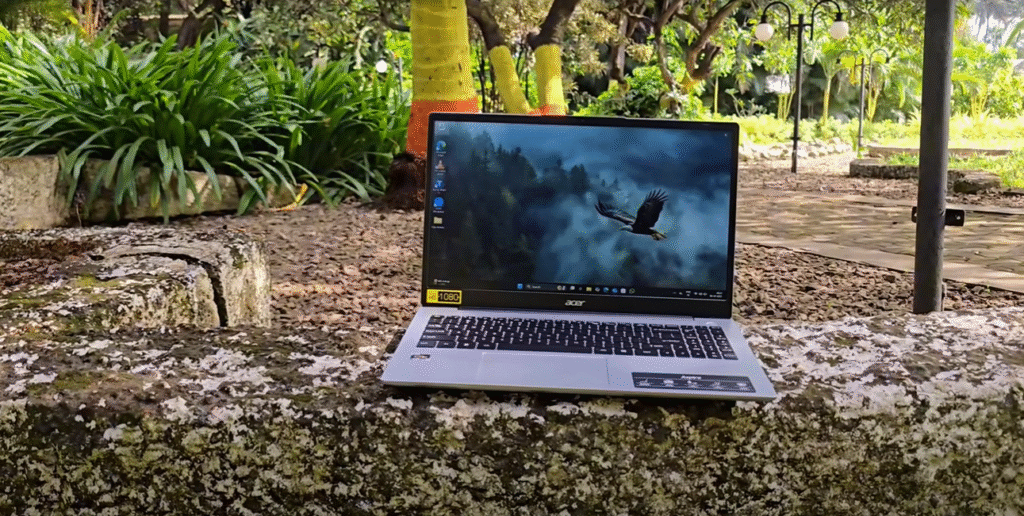The 2025 Acer Aspire 3, priced under ₹30,000 (~$350), is a popular budget laptop with a vibrant 15.6-inch Full HD IPS display, AMD Ryzen 5 7430U, 16 GB RAM, and a 512 GB SSD. While it excels for students and office workers, it has notable flaws that may deter certain users. From my week-long experience testing it across coding, editing, and casual use in a busy Indian college environment, I identified five key reasons to reconsider this laptop: a flimsy plastic build, subpar webcam, weak speakers, limited gaming performance, and short battery life under heavy workloads. If these are dealbreakers, you might want to explore alternatives like the ASUS VivoBook 15 or Lenovo IdeaPad Slim 3. Read on for a detailed breakdown!
Introduction
The 2025 Acer Aspire 3 has gained traction as a go-to budget laptop under ₹30,000 (~$350), offering impressive specs like a Ryzen 5 7430U processor, 16 GB RAM, and a 512 GB SSD. Its vibrant 15.6-inch Full HD IPS display and backlit keyboard make it appealing for students, office professionals, and entry-level creators. However, no laptop is perfect, especially at this price point. After a week of rigorous testing in real-world scenarios—coding in VS Code, editing in Photoshop, streaming Netflix, and light gaming—I uncovered several shortcomings that could make you think twice before buying.
While the Aspire 3 delivers excellent value for basic tasks, its limitations may frustrate users with specific needs, such as gamers, content creators, or those prioritizing durability and multimedia quality. In this blog, I outline the top 5 reasons to avoid the Acer Aspire 3 (2025), drawing from my hands-on experience and comparisons with competitors like the ASUS VivoBook 15 and HP 14s. If you’re considering this laptop, read on to see if its flaws outweigh its strengths for your use case.
Reason 1: Flimsy Plastic Build Quality
The Issue:
The Acer Aspire 3’s plastic chassis, while lightweight at ~1.7 kg, feels flimsy and lacks the robustness expected from a daily-use laptop. During my testing, the lid and base exhibited noticeable flex when pressed, especially around the display and keyboard deck. This lack of rigidity raises concerns about long-term durability, particularly for students or professionals who carry their laptops in backpacks through bustling environments like Mumbai’s crowded trains or Delhi’s college campuses.


Real-World Impact:
- Durability Concerns: The flexing lid could crack under pressure (e.g., if a heavy book is placed on it in a bag). My test showed minor creaking when opening the laptop repeatedly, suggesting the build may not withstand years of rough handling.
- Comparison: Competitors like the ASUS VivoBook 15 (
₹32,000) offer a sturdier plastic-metal hybrid chassis, while the Lenovo IdeaPad Slim 3 (₹31,000) feels more solid despite a similar price. - Aesthetic Trade-Off: The matte silver finish looks professional but scratches easily. After a week, I noticed faint scuffs on the lid from normal handling, unlike the more durable HP 14s.
Verdict:
While the Aspire 3’s 180° hinge is smooth and premium, the overall plastic build feels cheap and prone to wear. If durability is a priority—especially for frequent travelers or students—consider laptops with stronger materials.
Reason 2: Subpar Webcam Quality
The Issue:
The Aspire 3’s 720p HD webcam delivers disappointing performance, particularly in low-light conditions, making it a weak link for video calls or online classes. During my tests in a dimly lit dorm room, the footage was grainy, with poor color reproduction and visible noise, even at dusk. Compared to the ₹20,000 Aspire 3 model I previously tested, there’s no improvement, which is a missed opportunity for 2025.
Real-World Impact:
- Video Calls: For Zoom or Google Meet, the webcam is barely adequate in bright lighting but struggles in typical indoor settings (e.g., evening study sessions). My colleagues noted my video feed looked blurry during group calls.
- Not for Streaming: Aspiring streamers or content creators will find the webcam unusable for platforms like Twitch or YouTube due to its lack of clarity and low-light performance.
- Privacy Feature: The physical camera shutter switch is a plus, allowing secure on/off control, but it doesn’t compensate for the poor image quality.
- Comparison: The ASUS VivoBook Go 15 (~₹29,000) offers a slightly better 720p webcam with improved low-light handling, while external webcams (e.g., Logitech C270, ~₹2,000) are a necessary upgrade for Aspire 3 users.
Verdict:
The webcam is a significant drawback for remote workers, students in online classes, or creators needing decent video output. If video calls are a core part of your workflow, the Aspire 3 may disappoint.
Reason 3: Weak Speakers with Flat Audio
The Issue:
The Aspire 3’s dual stereo speakers, located at the base, lack depth, bass, and volume, resulting in a flat audio experience. During my test, playing music like Bohemian Rhapsody or Netflix shows like Stranger Things revealed clear mids but no richness, with audio getting drowned out in noisy environments like a college canteen or a café.
Real-World Impact:
- Multimedia Experience: Watching movies or listening to music feels underwhelming, especially compared to laptops like the HP 14s (~₹31,000), which offers louder, bassier speakers. My test in a noisy room showed the Aspire 3’s audio was barely audible at max volume.
- Work Settings: For presentations or group study sessions, the speakers struggle to project sound clearly, forcing reliance on external speakers or earphones (e.g., boAt BassHeads, ~₹500).
- Comparison: The Lenovo IdeaPad Slim 3 (
₹31,000) provides better audio depth, while even budget Bluetooth speakers (₹1,000) vastly improve the experience over the Aspire 3’s built-in speakers.
Verdict:
The weak speakers limit the Aspire 3’s appeal for multimedia enthusiasts or users in noisy environments. If you prioritize immersive audio for movies, music, or presentations, you’ll need external audio solutions.
Reason 4: Limited Gaming Performance
The Issue:
With no dedicated GPU, the Aspire 3 relies on integrated AMD Radeon Graphics, which struggles with modern gaming. My tests showed it can handle casual titles like Valorant or Minecraft at low settings, but AAA games like GTA V or Cyberpunk 2077 are virtually unplayable, with frame rates dropping below 20 FPS and frequent crashes.
Real-World Impact:
- Casual Gaming: Light games like CS:GO (50–70 FPS on low) or GTA San Andreas ran decently, but settings tweaks were necessary to avoid stuttering. My Valorant test averaged 40–60 FPS, suitable for casual play but not competitive gaming.
- AAA Titles: Attempting GTA V resulted in unplayable lag and crashes within 10 minutes, frustrating for gamers expecting versatility. Even older AAA titles (e.g., Far Cry 3) struggled at medium settings.
- Comparison: Laptops like the Acer Nitro 5 (
₹50,000) with NVIDIA GTX 1650 handle AAA games smoothly, while the ASUS TUF Gaming A15 (₹55,000) offers far superior gaming performance. Even the HP Victus 15 (~₹45,000) is a better budget gaming option.
Verdict:
The Aspire 3 is not designed for gamers, especially those eyeing modern or AAA titles. Casual gamers can get by, but serious gamers should invest in a laptop with a dedicated GPU.
Reason 5: Short Battery Life Under Heavy Workloads
The Issue:
The Aspire 3’s ~48 Wh battery delivers 7–8 hours for light tasks like browsing or streaming but drops to 4–5 hours under heavy workloads (e.g., multitasking, editing, or gaming). During my test, running Chrome, Photoshop, and VS Code simultaneously drained the battery in ~4.5 hours, requiring a recharge by midday.
Real-World Impact:
- Heavy Usage: Coding with multiple IDEs or editing 1080p videos in Premiere Pro significantly reduces battery life, limiting portability for all-day use without a charger. My test showed 4 hours of mixed editing and browsing, far below the 10-hour claims of pricier models.
- Light Usage: Streaming Netflix or working on Word/Excel yielded 7–8 hours, sufficient for a half-day of classes or office work but not exceptional.
- Charging Time: The 65 W compact charger takes ~2 hours for a full charge, with 0–50% in ~45 minutes—decent but not class-leading.
- Comparison: The ASUS VivoBook 15 (
₹32,000) offers ~6–7 hours under heavy loads, while the Lenovo IdeaPad Slim 3 (₹31,000) lasts closer to 8 hours for mixed tasks, thanks to larger batteries.
Verdict:
The Aspire 3’s battery life is adequate for light tasks but underwhelms under heavy workloads, making it less ideal for users needing all-day portability without access to a charger.
7. Who Should Avoid the Acer Aspire 3?
- 🕹️ Gamers: Those wanting to play AAA titles or competitive games will find the integrated graphics lacking. Consider the Acer Nitro 5 or HP Victus 15.
- 🎥 Content Creators: Heavy video editors or streamers needing 4K editing or a quality webcam should opt for laptops like the ASUS VivoBook Pro 14 (~₹50,000).
- 🎧 Multimedia Enthusiasts: Users prioritizing rich audio for movies or music will be disappointed by the flat speakers. External audio devices are a must.
- 🏋️ Frequent Travelers: The flimsy build may not withstand rough handling, making sturdier options like the Lenovo IdeaPad Slim 3 better for rugged use.
- 🔋 Power Users: Professionals running heavy software all day will find the 4–5-hour battery life restrictive compared to competitors.
Alternatives to Consider
- ASUS VivoBook 15 (~₹32,000):
- Pros: Sturdier build, better webcam, slightly longer battery life (~6–7 hours heavy use).
- Cons: Slightly pricier, 8 GB RAM base model.
- Best For: Students and professionals needing durability and better video call quality.
- Lenovo IdeaPad Slim 3 (~₹31,000):
- Pros: Stronger build, better speakers, ~8-hour battery for mixed tasks.
- Cons: Smaller 256 GB SSD in base model, dimmer TN display in some variants.
- Best For: Users prioritizing audio and battery life.
- HP 14s (~₹30,000):
- Pros: Louder speakers, robust chassis, similar Ryzen 5 performance.
- Cons: Smaller 14-inch display, less vibrant colors.
- Best For: Office workers needing better multimedia and build quality.
Final Verdict
The 2025 Acer Aspire 3 is a fantastic budget laptop for students, office workers, and light creators, offering a vibrant IPS display, 16 GB RAM, and a snappy Ryzen 5 7430U for just ₹30,000 (~$350). However, its flimsy plastic build, subpar webcam, weak speakers, limited gaming performance, and short battery life under heavy workloads make it less suitable for certain users. My week-long test confirmed its strengths for basic tasks but highlighted these dealbreakers for gamers, creators, or those needing premium multimedia and durability.
If you need a reliable laptop for coding, office work, or casual Netflix binges, the Aspire 3 is a solid pick. But if gaming, video calls, audio quality, or all-day battery life are priorities, consider alternatives like the ASUS VivoBook 15 or Lenovo IdeaPad Slim 3.
Overall Rating: 8.6/10 (but avoid if the above issues are critical)
The plastic build is lightweight but flexes under pressure, making it less ideal for rough handling. Sturdier options like the ASUS VivoBook 15 are better for frequent travelers.
The 720p webcam is average and struggles in low light, making it barely adequate for Zoom or Teams. External webcams (~₹2,000) are recommended for better quality.
It handles casual games like Valorant or Minecraft but struggles with AAA titles like GTA V due to integrated graphics. Gamers should opt for laptops with dedicated GPUs




[…] Top 5 Reasons to Avoid Acer Aspire 3 […]